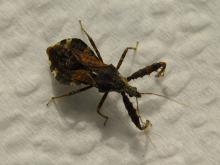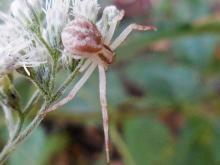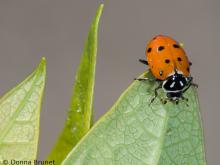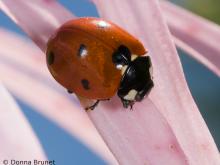Land Invertebrates
Media

Species Types
Scientific Name
Araneus marmoreus
Description
The marbled orbweaver is sometimes called the “pumpkin spider” because its rounded abdomen is sometimes bright orange. The color and markings can vary greatly.
Media

Species Types
Scientific Name
Sinea spinipes
Description
The spiny assassin bug is one of nearly 200 species of assassin bugs in North America. It walks, hops, and flies to capture its insect prey.
Media

Species Types
Scientific Name
Mecaphesa asperata
Description
The northern crab spider has many spiny hairs covering the top surfaces of the carapace, abdomen, and legs, and it has usually has greenish-yellow or yellow-brown markings.
Media

Species Types
Scientific Name
Mecaphesa celer (formerly Misumenops celer)
Description
The swift crab spider has many spiny hairs covering the top of its body and legs, and it often has a light pinkish-tan cast.
Media

Species Types
Scientific Name
Misumessus oblongus (formerly Misumenops oblonga)
Description
The green crab spider has spines, and the entire body and legs are pale green to silvery white. Like other crab spiders, its legs extend outward from the sides, and it can walk in any direction.
Media

Species Types
Scientific Name
Hippodamia convergens
Description
One of our many native lady beetles, the convergent lady beetle is named for two short white lines on the black pronotum (shoulderlike section behind the head) that converge toward each other.
Media

Species Types
Scientific Name
Cycloneda munda
Description
The polished lady beetle lacks spots. One of our many native lady beetles, it eats aphids, which endears it to gardeners and farmers.
Media

Species Types
Scientific Name
Neoharmonia venusta
Description
The V-marked lady beetle, one of our many native lady beetles, is very attractive. The pattern and coloration can vary greatly among individuals, but most in this species have a V on the back.
Media

Species Types
Scientific Name
Brachiacantha quadripunctata
Description
Not all Missouri lady beetles are red with black spots. The four-spotted lady beetle reverses the pattern.
Media

Species Types
Scientific Name
Coccinella septempunctata
Description
The seven-spotted lady beetle is native to Eurasia and was introduced to our continent to combat aphid pests. It is now well established in North America.
See Also



Media

Species Types
Scientific Name
Cisseps fulvicollis
Description
The yellow-collared scape moth is more often “orange-collared.” And whether you think it looks more like a firefly or a wasp, it’s still a moth!
Media

Species Types
Scientific Name
Nearly 150 species in North America north of Mexico
Description
Slim, delicate plume moths are instantly recognizable by their T-shaped silhouette, long legs, and muted shades of tan and brown. It can be hard to separate the various species.
Media

Species Types
Scientific Name
Pyrrharctia isabella
Description
Not many people know the adult Isabella tiger moth when they see one, but we’re all acquainted with its caterpillar, the woolly worm, or woolly bear.
About Land Invertebrates in Missouri
Invertebrates are animals without backbones, including earthworms, slugs, snails, and arthropods. Arthropods—invertebrates with “jointed legs” — are a group of invertebrates that includes crayfish, shrimp, millipedes, centipedes, mites, spiders, and insects. There may be as many as 10 million species of insects alive on earth today, and they probably constitute more than 90 percent all animal species.





















